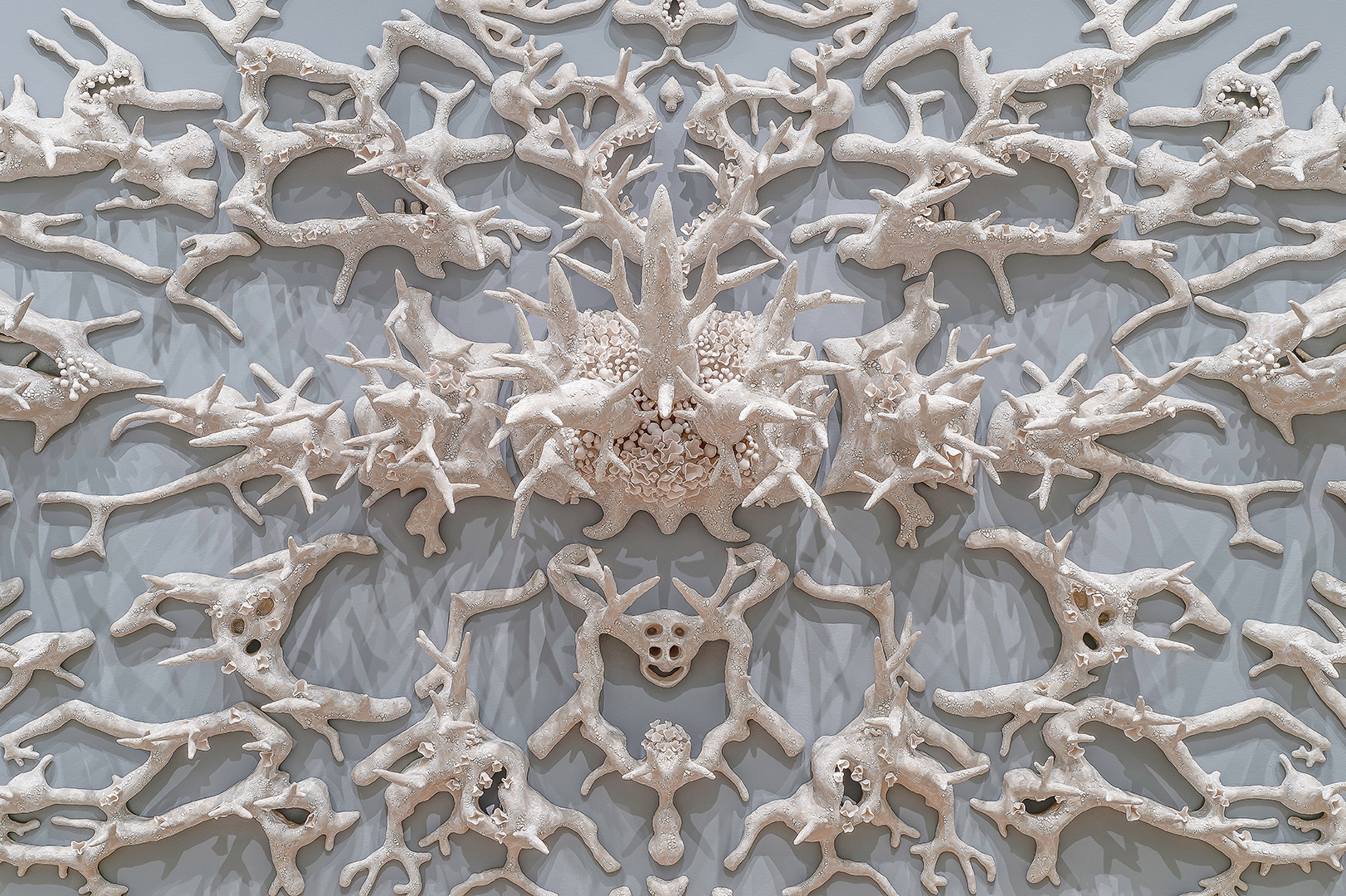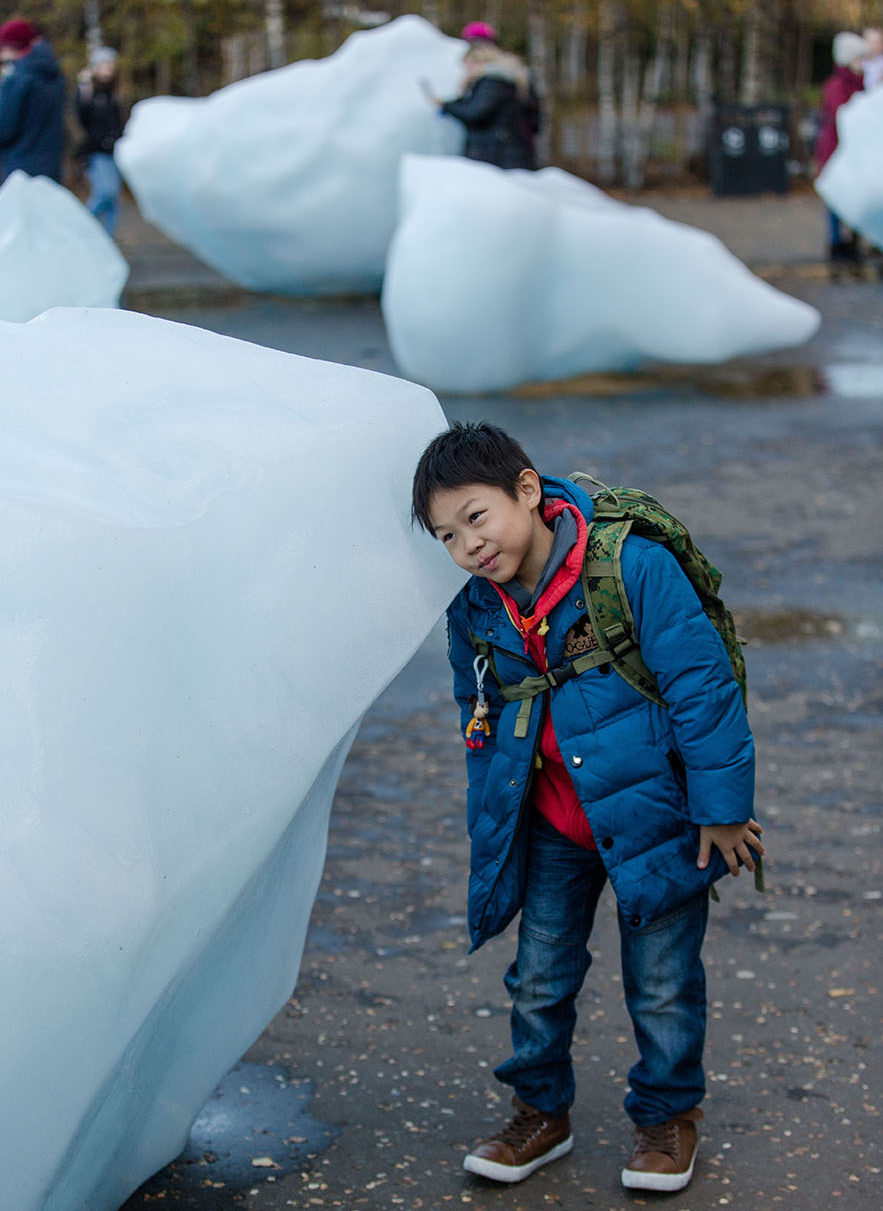Climate Art Beat℠
Summer/Early Fall Calendar 2019

Courtney Mattison, Malum Geminos (“Evil Twins” in Latin)(detail)(2019). Glazed stoneware and porcelain. Dimensions: 7’ x 21’ x 2’. Photograph by Paul Mutino for the Florence Griswold Museum. ©2019 Courtney Mattison. Courtesy of the artist. On exhibit at the Florence Griswold Museum.
We are pleased to highlight these 10 pioneering climate art events.
Chicago, IL

James Balog, Blue Ponds Formed by Meltwater in Alaska’s Columbia Glacier (left) and Meltwater River Formed by Glacier Melt in Greenland (right). Photographs. ©2014 James Balog/Extreme Ice Survey. Courtesy of the artist and Museum of Science and Industry.
Museum of Science and Industry
Extreme Ice captures the immediacy of climate change with James Balog’s visually stunning photographs and time-lapse videography of melting glaciers. To illustrate the physical and technological challenges Balog and his team had to overcome to gather this compelling footage, the exhibition displays their customized camera, expedition equipment, and a touchable 7-foot tall ice wall.
Now to Nov., 2020
Providence, RI

Xavier Cortada, Brother Sun (2015). Digital art celebrating Pope Francis’ environmental encyclical, Laudato Si’ (Praised Be), and its quotation from St. Francis’ Canticle of the Creatures. ©2015, Xavier Cortada. Courtesy of the artist.
University of Rhode Island Providence Campus Gallery
Climate Change: Art & Action showcases the work of 15 pioneering artists whose work is motivated by concern over climate change. Over 75 visually powerful works collectively explore how climate change is impacting our earth and propose sustainable responses to our climate challenge. The exhibition also features Let’s Explore, Honoring the Future’s 360° virtual reality film about climate change. The exhibition is presented by Honoring the Future in partnership with the University.
Sept. 3 – 26, 2019
Old Lyme, CT

Courtney Mattison, “Our Changing Seas IV” (2019). Glazed stoneware and porcelain. Dimensions:11’ x 17’ x 2’. Photograph by Courtney Mattison. ©2019 Courtney Mattison. Courtesy of the artist.
Florence Griswold Museum
In Fragile Earth: The Naturalist Impulse in Contemporary Art, four leading contemporary artists create new installations from natural and non-traditional materials to make visible the human role in climate change and to show how our daily choices may endanger our planet’s future.
Now through Sept. 8, 2019
Philadelphia, PA

Tempestries indicating changes in local temperature over a period of years. Photo courtesy of the Tempestry Project. © The Tempestry Project.
Schuylkill Center for Environmental Education
Schuylkill Center volunteers are knitting and crocheting “tempestries” or “temperature tapestries” – visual presentations of climate data. Each tapestry is a knitted bar graph showing local temperature change over time, with blues/greens indicating cooler, and reds/oranges signaling warmer, periods. The volunteers are part of the Tempestry Project, a nationwide initiative designed to raise awareness of climate change. The 30-piece collection of Tempestries for Philadelphia from 1875 – 2018 will be completed and on long-term view at the Schuylkill Center starting this fall.
Now through Fall, 2019
Boston, MA

Olafur Eliasson, Northwest Passage (2018). Stainless steel, LED lights, diffusers. Dimensions: approximately 90 ft. long. Commissioned by Massachusetts Institute of Technology. Photograph by Anton Grassi ©Olafur Eliasson.
Massachusetts Institute of Technology, MIT.nano Building
Olafur Eliasson’s Northwest Passage references the sea route opening across the Arctic as ice coverage dwindles. Eliasson’s polished stainless steel panels evoke free-floating sea ice. As the ice melts, passage becomes easier, encouraging shipping which, in turn, burns fossil fuels, melting more ice. An optical illusion invites closer observation of this paradox: the installation’s semi-circular light rings, mirrored in steel, seem fully circular as the viewer changes position, a wry comment on our fleeting attention to climate change.
Permanent Installation
New York, NY

Michael Strano, MIT Chemical Engineering, and Sheila Kennedy, MIT Architecture, Massachusetts Institute of Technology and KVA Studio (United States), Nanobionic Plant Project: Ambient Illumination (2016-ongoing). Nanobionic watercress plants. Dimensions variable. Courtesy of MIT Professor S. Kennedy & Professor M. Strano Research Groups. ©Cooper Hewitt Press Images. On exhibit at the Cooper Hewitt Museum.
Cooper Hewitt Museum
Nature By Design features more than 60 groundbreaking works from designers collaborating with scientists, engineers, farmers, environmentalists, and nature itself to devise creative solutions to the crisis of human-caused climate change.
Now through Jan. 20, 2020
Bethlehem, PA

The Toxic Reef at the Smithsonian’s National Museum of Natural History, Washington, D.C., 2011. Photo courtesy of Lehigh University.
Lehigh University Zoellner Art Center
Drawing on art, science, geometry and environmental activism, Crochet Coral Reef: By Margaret and Christine Wertheim and the Institute for Figuring, is an evolving archipelago of crocheted wool installations emulating natural coral reef structures. The Reef calls attention to global warming’s devastating impact on coral reefs and has spawned satellite reefs across the globe. Visitors to the Lehigh exhibition can experiment with hands-on crochet and contribute to the Lehigh University Satellite Reef.
Sept. 12 – Dec. 8, 2019
Hudson Valley, NY

Jean Shin, Process documentation for Allee Gathering (2019). Recycled maple wood and steel. Dimensions variable. © Jean Shin 2019. Photo courtesy of the artist.
Storm King Art Center
Jean Shin’s monumental picnic table, titled Allee Gathering, preserves the memory of 24 declining maple trees, which were replaced with trees better able to withstand changes in local climate and ground conditions. Shin’s table creates a communal place to rest, observe, reflect and converse and calls attention to the importance of tree health and land conservation in a changing climate. Also on display (until Nov. 11) are Mark Dion’s signature architectural Follies, compact structures exploring the intersections among art, nature, and culture.
May 4 – Nov. 24, 2019
Sorrento, Italy

Dalya Luttwak, Global Warning: First Tropical Mangrove in Venice (detail)(2018). Painted aluminum. Dimensions: 3m x 2m. ©Dalya Luttwak, 2018. Courtesy of the artist.
Villa Fiorentino
Global Warning: First Tropical Mangrove in Venice, Dalya Luttwak’s sculpture, calls art-lovers to care that rising seas and an ever-warming climate threaten Venice, its people, and its future. This sculpture was previously exhibited in the Giardini Marinaressa for the 2018 Venice Biennale.
Now through summer 2019
London, England

Olafur Eliasson and Minik Rosing, Ice Watch (2018). Installation of blocks of melting ice, which had already broken off the Greenland ice sheet, at Bankside outside London’s Tate Modern gallery. ©2018 Olafur Eliasson. Courtesy of the artist. Photograph by Charlie Forgham Bailey.
Tate Modern
Olafur Eliasson: In Real Life showcases over 30 artworks – the most comprehensive solo presentation of Eliasson’s work to date. Eliasson’s deep engagement with social and environmental issues surfaces in solar-powered lighting projects and Ice Watch, an installation calling public attention to melting glacial ice. Reaching beyond the gallery, Studio Olafur Eliasson collaborated with the Tate’s Terrace Bar on a special menu featuring organic, vegetarian and ethically produced food, similar to daily meals Eliasson shares with his Studio staff.
Now through Jan. 5, 2020
